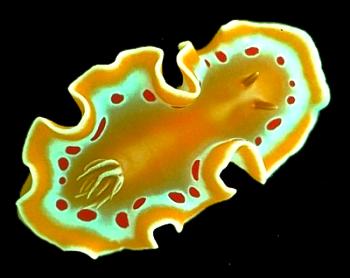
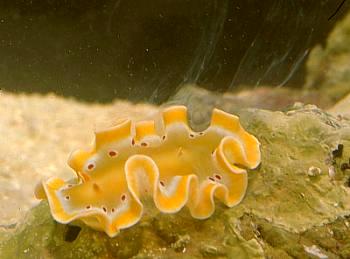
Glossodoris cruenta
Rudman, 1986
Order: NUDIBRANCHIA
Suborder: DORIDINA
Superfamily: EUDORIDOIDEA
Family: Chromodorididae
DISTRIBUTION
Tropical Western Pacific
PHOTO
UPPER: Rocky Point, Lizard Is., Queensland, Australia. December 1975. Photo: Ian Loch
LOWER: Lizard Is., Queensland. 1974. Note mucous secretions streaming from mantle glands. Photo: Geoff Biddle.
Quite similar in colour to Glossodoris rubroannulata which differs in having a thin red line along the outer edge of the white rather than red spots along the inner edge.
Reference:
• Rudman, W.B. (1986) The Chromodorididae (Opisthobranchia: Mollusca) of the Indo-West Pacific: The genus Glossodoris Ehrenberg (= Casella, H. & A. Adams). Zoological Journal of the Linnean Society 86(2): 101-184.
Rudman, W.B., 2000 (October 25) Glossodoris cruenta Rudman, 1986. [In] Sea Slug Forum. Australian Museum, Sydney. Available from http://www.seaslugforum.net/find/gloscrue
Related messages
Albino Glossodoris cruenta? from sthn Queensland
June 1, 2010
From: Ian Banks
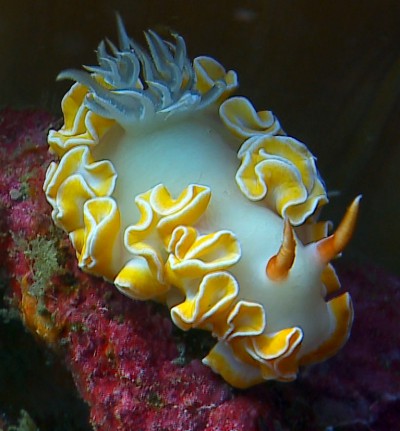
Hi Bill,
Here is a Glossodoris sp. at Shellacey Reef, Gneering Shoals near Mooloolaba Sunshine coas 22-May-2010. In about 15 metres depth, 5 cm in length. Seems to be a new species. Recorded on video, still images are off the video. video clip is on youtube: http://www.youtube.com/watch?v=x62g9AX9Jx0
Locality: Shellacey Reef, Gneering Shoals near Mooloolaba, Sunshine Coast, 15 metres, Queensland Australia, Pacific Ocean, 22 May 2010, Reef. Length: 5 cm. Photographer: Ian Banks.
Ian Banks
ianbanks@bigpond.com
Banks, I.W., 2010 (Jun 1) Albino Glossodoris cruenta? from sthn Queensland. [Message in] Sea Slug Forum. Australian Museum, Sydney. Available from http://www.seaslugforum.net/find/23683
Dear Ian
Thanks for the photo. Although its always possible that this is a new species, my guess is that it's a strange colour form of Glossodoris cruenta. In the similar G. rubroannulata the yellow in the centre of the mantle is sometimes missing so its possible the same could happen in G. cruenta.
Your animal has the white border right at the mantle edge, as in G. cruenta, and also has the broad opaque white outer edge to the gills, which are both characters which separate G. cruenta from G. rubroannulata. I know that your animals doesn't have the spectacular red spots or the yellow on the inner mantle but funny things seem to happen in the southeastern Queensland - nthn New South Wales region. For example I suspect Chromodoris buchananae is a strange colour form of C. kuiteri.
It is certainly an interesting find. Let's hope you can find some more specimens
Best wishes,
Bill Rudman
Glossodoris cruenta from Lembeh Strait
December 5, 2006
From: Mike Krampf
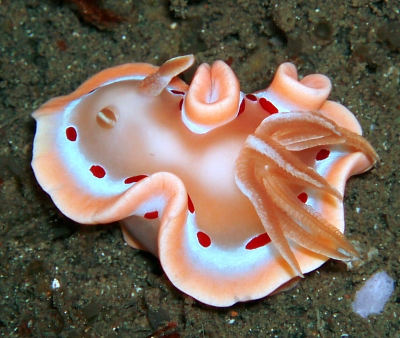
Concerning message #18378:
I thought I'd share these pics of a Glossodoris cruenta since all the other postings on this species are from the Soloman Islands.
Locality: DIve Site - Mawali Wreck, 100 ft, Lembeh Strait, Indonesia, Celebes Sea, 27 October 2006, Sandy bottom. Length: 15 mm. Photographer: Mike Krampf.
Mike
mtkrampf@yahoo.com
Krampf, Mike, 2006 (Dec 5) Glossodoris cruenta from Lembeh Strait. [Message in] Sea Slug Forum. Australian Museum, Sydney. Available from http://www.seaslugforum.net/find/18771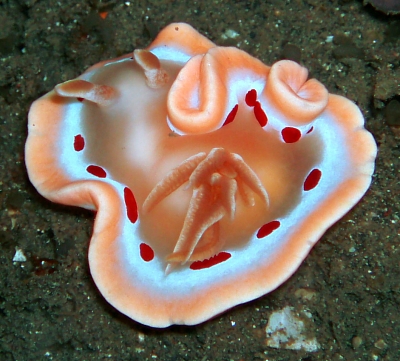
Dear Mike,
Amongst the chromodorids, which are reknowned for their gaudy colour patterns, this must rate as one of the most ostentatious. It would be great to get more information on the food sponge of this species.
Best wishes,
Bill Rudman
Beautiful chromodorid from East Timor
July 28, 2006
From: Brian Francisco
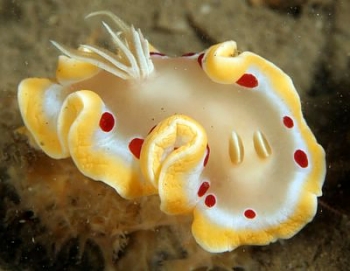
Hi Bill
We found this beautiful chromodorid yesterday. Can you tell us the species name?
Locality: Beach, 27 metres, East Timor, Banda Sea, 23 July 2006, coral reef. Length: 4cm. Photographer: Brian Francisco.
Thanks very much
Brian
www.uwet.net
francisco.brian@gmail.com
Francisco, B., 2006 (Jul 28) Beautiful chromodorid from East Timor. [Message in] Sea Slug Forum. Australian Museum, Sydney. Available from http://www.seaslugforum.net/find/17218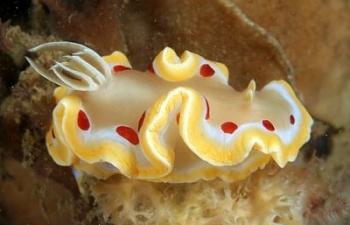
Dear Brian,
This is Glossodoris cruenta. Like Platydoris cruenta its name comes from a Latin word for 'bloody' or 'spotted with blood'.
I may be wrong, but in the lower photo your animal seems to have caused some damage to the sponge it is on. If you have any higher resolution photos showing more of the sponge I would be interested in seeing them. It might give us a clue to what it is eating.
Best wishes,
Bill Rudman
Glossodoris cruenta from Solomon Ids
April 29, 2003
From: Bruce Potter
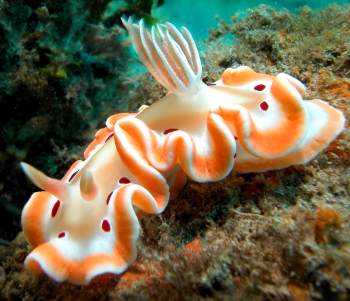
Dear Bill,
I was diving recently [April 2003] on a small boat wreck on the outskirts of Honiara, Solomon Islands when my dive buddy found this Glossodoris cruenta
It would have been about 45mm long, and at about 12 meters deep. This is not a common slug in these parts.
Regards
Bruce Potter
bruce.potter@adventist.org.sb
Potter, B., 2003 (Apr 29) Glossodoris cruenta from Solomon Ids. [Message in] Sea Slug Forum. Australian Museum, Sydney. Available from http://www.seaslugforum.net/find/9754Thanks Bruce,
This doesn't seem to be a common species anywhere - which brings up the question of why some species are common and some are apparently rare. I'm afraid I don't know if there is an answer to that question but it is a useful way to get a discussion going.
I must say this animal is much more orange than usual, but I see an earlier photo you sent is of an animal almost intermediate in colour between the normal yellow colour form and this orange one.
Best wishes,
Bill Rudman
Glossodoris cruenta from Solomon Ids
May 4, 2002
From: Bruce Potter
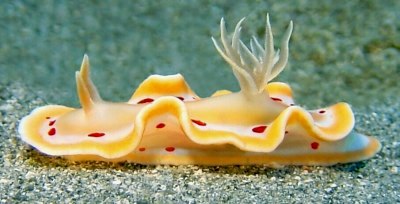
Dear Bill,
Yesterday I dived the Bonegi shipwrecks, just outside of Honiara, Solomon Islands.
On Bonegi 1, I found this beautiful example of Glossodoris cruenta. This is only the third time I have found G. cruenta in the Solomons.
It was about 50mm long, and crawling across the sand at about 8 meters.
Regards
Bruce Potter.
bruce.potter@adventist.org.sb
Potter, B., 2002 (May 4) Glossodoris cruenta from Solomon Ids. [Message in] Sea Slug Forum. Australian Museum, Sydney. Available from http://www.seaslugforum.net/find/6794Dear Bruce,
It still seems quite a mystery why some species are rare and others with similar requirements and similar habits are quite common.
Best wishes,
Bill Rudman
Glossodoris cruenta from the Solomon Islands
December 14, 2001
From: Mary Jane Adams
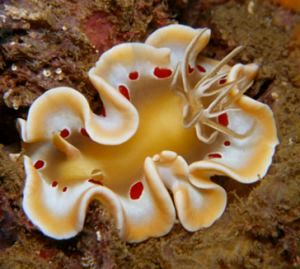
Hi Bill,
I photographed this Glossodoris cruenta last month [November 2001] on a WW II Japanese pier piling on Ghavutu Island in the Florida Group of the Solomon Islands. The only other time I have seen this beautiful nudibranch was on the same pier in 1994. The divemaster told me that there are only a few sightings a year in the Florida and Russell Islands.
Depth: 1 meter
Length: about 3 cm.
Best regards,
Mary Jane
divepng@yahoo.com
Adams, M.J., 2001 (Dec 14) Glossodoris cruenta from the Solomon Islands. [Message in] Sea Slug Forum. Australian Museum, Sydney. Available from http://www.seaslugforum.net/find/5812Thanks Mary Jane,
Bill Rudman
Glossodoris cruenta with inverted gills
December 8, 2001
From: Michael D. Miller
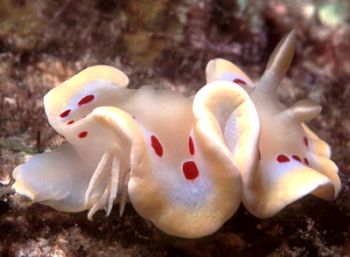
Dear Bill
here is another image for your strange and bizarre list!
Location: Batangas, Philippines
Date: March, 1995
Photographer: Michael Miller
Cheers;
Michael D. Miller
mdmiller@cts.com
Miller, M.D., 2001 (Dec 8) Glossodoris cruenta with inverted gills. [Message in] Sea Slug Forum. Australian Museum, Sydney. Available from http://www.seaslugforum.net/find/5784Thanks Michael,
This is like Scott Johnson's photo of a Chromodoris geometrica. As I mentioned with Scott's message, Charles Eliot described a specimen of Hypselodoris infucata as a new species and genus, Chromodoridella mirabilis Eliot 1905, because it had the gills attached like this below the mantle edge. It's certainly interesting to see how some of these abnormalities are apparently occurring across a number of species, suggesting a common developmental error.
Cheers,
Bill Rudman
Red and black-spotted Glossodoris cruenta
October 29, 2000
From: Bruce Potter
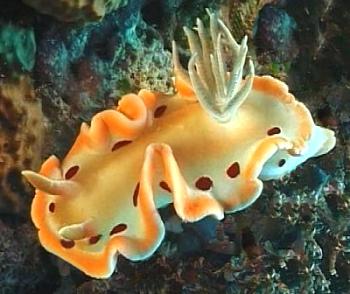
Bill,
The G. cruenta that I sent you a couple of days ago really did have black spots. I have it on video, and it is very clear. I have included another G. cruenta with this message that has the normal red spots. I found this one at the dive site, "Velvia" in the Florida group of islands in the Solomons. This is for my money the best critter dive site in the Solomons.
It was at about 18 meters under a coral head.
These are the only two times I have found G. cruenta here.
Regards Bruce.
bruce.potter@adventist.org.sb
Potter, B., 2000 (Oct 29) Red and black-spotted Glossodoris cruenta. [Message in] Sea Slug Forum. Australian Museum, Sydney. Available from http://www.seaslugforum.net/find/3255Dear Bruce,
Thanks for the photo. Sorry if I seemed to doubt your black spots but I have seen some strange colours caused by faulty exposures, faulty film and film processing over the years so I have to ask. It certainly convinces me that you had a black-spotted animal. A very interesting find.
Best wishes,
Bill Rudman.
Glossodoris cruenta from Solomons
October 28, 2000
From: Bruce Potter
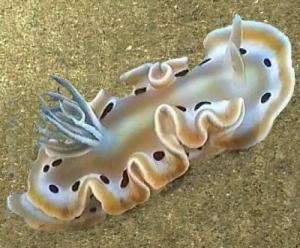
Bill,
I am sending you a photo of Glossodoris cruenta which, as the name suggests, should have red spots. This particular one had black spots instead.
It was filmed at the "Wreck of the Anne" dive site in the Russell islands, in the Solomons. It was at about 8 meters, on a mixed rubble and coral site.
Bruce Potter
bruce.potter@adventist.org.sb
Potter, B., 2000 (Oct 28) Glossodoris cruenta from Solomons. [Message in] Sea Slug Forum. Australian Museum, Sydney. Available from http://www.seaslugforum.net/find/3242Dear Bruce,
It certainly looks like G. cruenta. Any chance of the black being a trick of light absorption or the vide film? Failing that I guess we have a interesting peculiarity.
Best wishes,
Bill Rudman.
